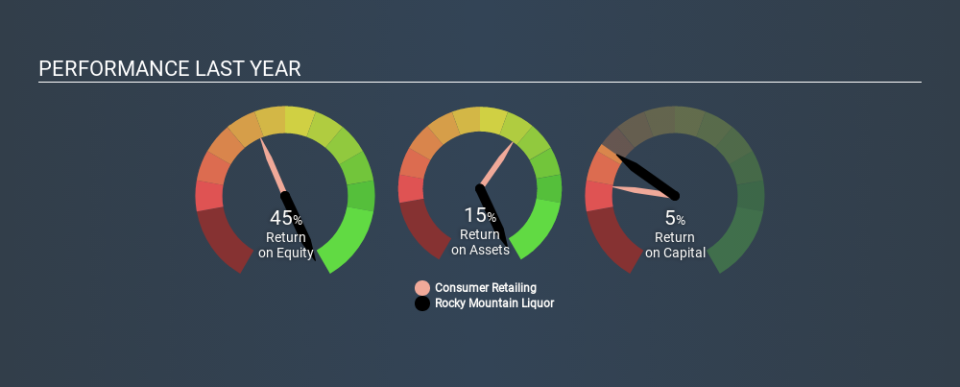Rocky Mountain Liquor Inc. (CVE:RUM) Might Not Be A Great Investment

Today we'll evaluate Rocky Mountain Liquor Inc. (CVE:RUM) to determine whether it could have potential as an investment idea. Specifically, we'll consider its Return On Capital Employed (ROCE), since that will give us an insight into how efficiently the business can generate profits from the capital it requires.
First up, we'll look at what ROCE is and how we calculate it. Second, we'll look at its ROCE compared to similar companies. And finally, we'll look at how its current liabilities are impacting its ROCE.
What is Return On Capital Employed (ROCE)?
ROCE is a metric for evaluating how much pre-tax income (in percentage terms) a company earns on the capital invested in its business. All else being equal, a better business will have a higher ROCE. Ultimately, it is a useful but imperfect metric. Author Edwin Whiting says to be careful when comparing the ROCE of different businesses, since 'No two businesses are exactly alike.
How Do You Calculate Return On Capital Employed?
Analysts use this formula to calculate return on capital employed:
Return on Capital Employed = Earnings Before Interest and Tax (EBIT) ÷ (Total Assets - Current Liabilities)
Or for Rocky Mountain Liquor:
0.054 = CA$889k ÷ (CA$27m - CA$11m) (Based on the trailing twelve months to September 2019.)
So, Rocky Mountain Liquor has an ROCE of 5.4%.
Check out our latest analysis for Rocky Mountain Liquor
Does Rocky Mountain Liquor Have A Good ROCE?
One way to assess ROCE is to compare similar companies. Using our data, Rocky Mountain Liquor's ROCE appears to be significantly below the 8.4% average in the Consumer Retailing industry. This performance could be negative if sustained, as it suggests the business may underperform its industry. Setting aside the industry comparison for now, Rocky Mountain Liquor's ROCE is mediocre in absolute terms, considering the risk of investing in stocks versus the safety of a bank account. It is possible that there are more rewarding investments out there.
We can see that, Rocky Mountain Liquor currently has an ROCE of 5.4% compared to its ROCE 3 years ago, which was 2.2%. This makes us wonder if the company is improving. The image below shows how Rocky Mountain Liquor's ROCE compares to its industry, and you can click it to see more detail on its past growth.
When considering ROCE, bear in mind that it reflects the past and does not necessarily predict the future. ROCE can be deceptive for cyclical businesses, as returns can look incredible in boom times, and terribly low in downturns. ROCE is only a point-in-time measure. How cyclical is Rocky Mountain Liquor? You can see for yourself by looking at this free graph of past earnings, revenue and cash flow.
Rocky Mountain Liquor's Current Liabilities And Their Impact On Its ROCE
Current liabilities include invoices, such as supplier payments, short-term debt, or a tax bill, that need to be paid within 12 months. Due to the way the ROCE equation works, having large bills due in the near term can make it look as though a company has less capital employed, and thus a higher ROCE than usual. To check the impact of this, we calculate if a company has high current liabilities relative to its total assets.
Rocky Mountain Liquor has current liabilities of CA$11m and total assets of CA$27m. As a result, its current liabilities are equal to approximately 40% of its total assets. Rocky Mountain Liquor's middling level of current liabilities have the effect of boosting its ROCE a bit.
Our Take On Rocky Mountain Liquor's ROCE
With this level of liabilities and a mediocre ROCE, there are potentially better investments out there. Of course, you might also be able to find a better stock than Rocky Mountain Liquor. So you may wish to see this free collection of other companies that have grown earnings strongly.
If you are like me, then you will not want to miss this free list of growing companies that insiders are buying.
If you spot an error that warrants correction, please contact the editor at editorial-team@simplywallst.com. This article by Simply Wall St is general in nature. It does not constitute a recommendation to buy or sell any stock, and does not take account of your objectives, or your financial situation. Simply Wall St has no position in the stocks mentioned.
We aim to bring you long-term focused research analysis driven by fundamental data. Note that our analysis may not factor in the latest price-sensitive company announcements or qualitative material. Thank you for reading.

 Yahoo Finance
Yahoo Finance 
